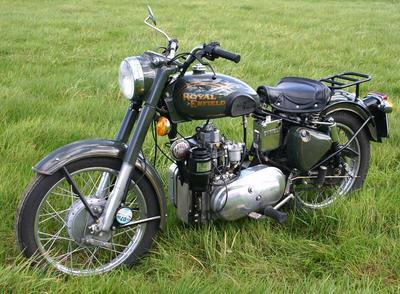So this is Sluggy the diesel, so named because of his less than impressive turn of speed and original colour.
Coming from
F2 motorcycles and having been rebuilt in India he was complete with brand new 360cc Greaves diesel engine and a 5 speed box.
The finish is a bit rough and ready and perhaps less than one would expect from a bike that had been rebuilt in the UK but this was reflected in the price. The pinstriping is stick on plastic and the paint had a fair amount of orange peel surface but overall the bike is well appointed.
I was warned at the start that running in would need care, push it too hard and it will seize, and yes it will but it does so softly and frees up once cooled down a bit. Normally running in for this type of industrial engine would be 24 hours on half load followed by a further 24 on 75% load and so the whole job would be accomplished in two days; needless to say it takes a bit longer in a motorcycle.
Naturally the first thing to do with a classic old motorcycle is to put it to work in commuting duties, at 160 mpg it needs to earn his keep.
Sluggys life has not been an easy one, after about 3 months useage and returning home from a bike show (how many miles to the gallon mate......really!) I was rear ended by a Fiesta on the A12.
It distroyed the rear end pretty well, rear light, subframes and mudguard were written off, but Enfields are tough bikes and I made it home after leaving the damaged parts at the side of the road.
With the help of fellow Bulletmaniacs Sluggy managed to live again, albeit with a leftover purple 500 rear end (it's a good thing trials conversions are popular - leaves lots of lovely unused kit to be salvaged).
This accident however distroyed the rare deep section rear mudguard.
Saddles might look nice and classic, but I never got on with this one, I removed the pillion as soon as I got the bike, there was no way the bike had enough power to take one anyway. I replaced this with a small carrier.
The leather saddle caused me a few headaches, in the first week the front springs collapsed, by the end of the second month all the rivets had rusted and there were definite signs of mildew in the leather cover. I got a bit fed up with this and replaced it with an unsprung single seat from the 'Street' version of the bullet. It also covers the electrics a whole lot better.
Indicators never look right on an old bike, and returning home one winters evening through the unlit lanes of Rainham flats the bike suffered from a total wiring loom melt down.
As this had no effect whatsoever on the engine i managed to return home by the use if a bicycle flashing LED on the rear carrier and a pocket torch I carry for emergencies gaffa taped to the side of my helmet - try that on a petrol bike.
One home brewed rewire later (many old kettle leads gave their lives in support) and a more substantial wiring setup could not be possible - sans indicators of course!
One should note that a horn consumes quite a bit of current and will blow a 5 amp fuse, now replaced with a natty circuit breaker - note the tiny gel battery, yours for a fiver at Maplins.
The bike is wired to run with or without the battery, the horn works better with.
Performance was never going to be Sluggys main feature, but a 40mph max was just taking the biscuit.
Upgrading the gearing with an 18t sprocket was a definite improvement, this is the same as the petrol 500 but as the engine only revs to 3500.........
One very worthwhile upgrade was a set of modified rockers from
Jochen Sommer in Germany, he cuts and re-welds them to increase lift and very well they work too.
For that bit extra how about some LPG fumigation, yes it works.
Problems
Surprisingly few, the worst is getting air into the fuel line, this will bring the motor to a halt quickly.
I've replaced the natty alloy cartridge fuel filter and replaced this with a disposable from Halfords and some see through piping. Resealing the banjo connections has proved a challenge, after various different washers I've settled on some generic fibre types again from a Halfords mix pack.
The cool class bowl filter is an eBay item, it has a magnet in the base to grab any rust flakes that fall through. I've retained the paper filter because the injector has really tiny holes and fule should be filtered to 1 micron!
The kick starter is getting stiff and won't return on it's own nowerdays, but kick starting a compression of 18.5:1 is a challenge all of it's own, make sure you get it right.
The Future
So what lies in store, well I have aquired a set of ribbed and valanced mudguards that should suit him better, also a colour change to French Blue is on the cards, I just need to get better at coach painting. The tank is a bit specific, it has a return fuel line that takes overflow fuel from the injector so doing my usual swap out for another once refinished will be a bit problematic.
So if you see a heavily smoking bike ridden by a manicaly grinning pilot attempting to get over 50mph downhill with the wind behind then that will be me - give a smile and a wave.
All the best
Diesel Dave
If you need any help with diesel tuning matters; look no further than Diesel Bob, always ready with friendly advice:
